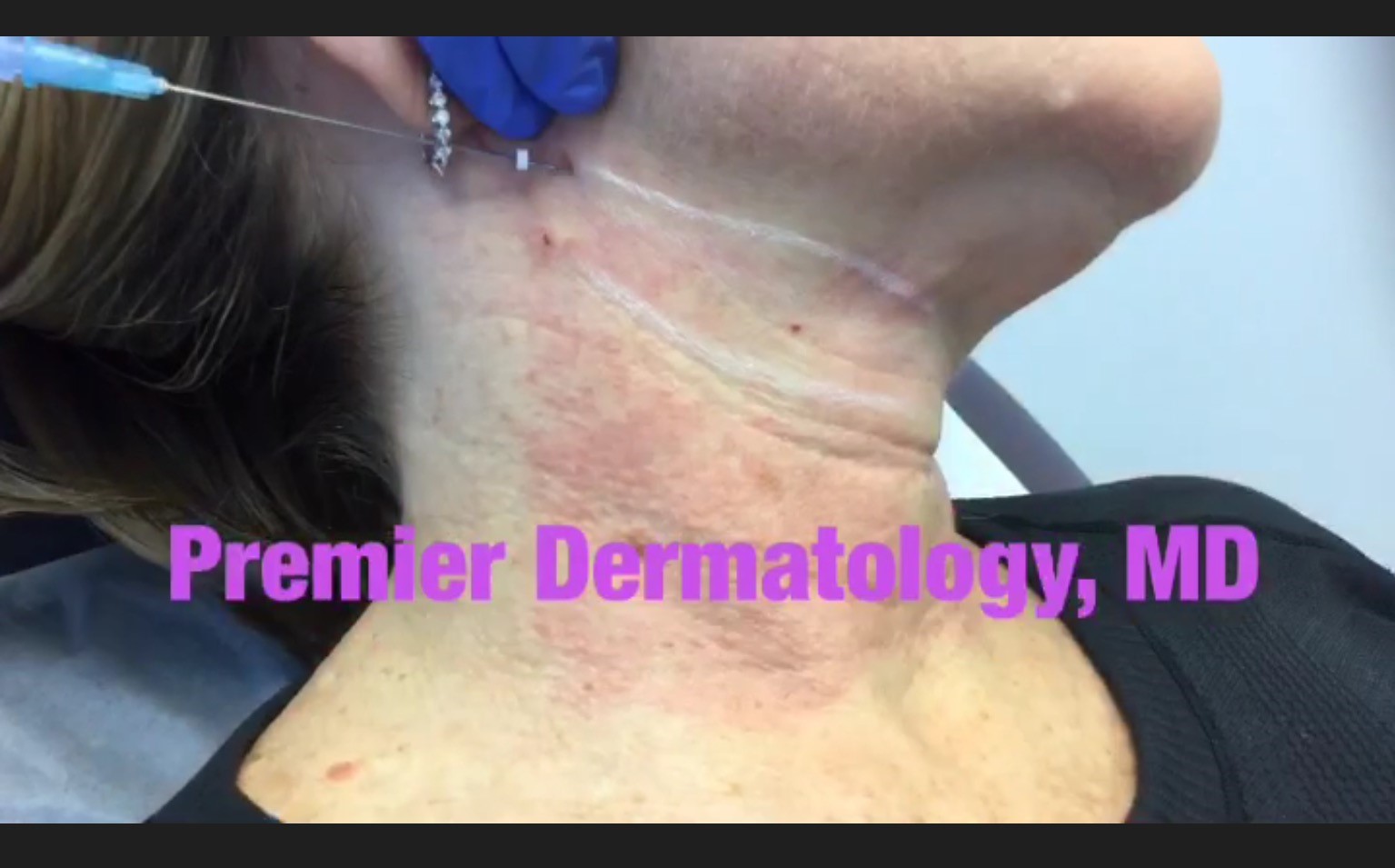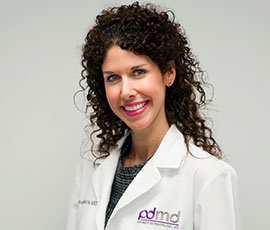Novathreads at pdmd!

Dr. Donna Bilu Martin is always looking to stay on the cutting edge of aesthetics and carefully chooses procedures that are safe and effective for patients. It is very exciting to offer Novathreads at Premier Dermatology, MD!
Novathreads are needles that are preloaded with an absorbable suture (thread) made of PDO, or polydioxanone. PDO is a safe material that is commonly used in surgery and is absorbed by the body within 6 months. Multiple treatments may be recommended for optimal results. The procedure is very comfortable and well tolerated, with minimal downtime. It is performed in the office with topical and local anesthesia.
There are two main ways that Novathreads are used:
1. Barbed threads are strategically placed under the skin and grips tissue to lift. The skin builds new collagen to secure the lift. These are especially useful in the lower face and neck.
2. Smooth threads are placed more superficially in wrinkles, like marionette lines, or along perioral lines (Smoker's lines). Or, the smooth threads can be placed vertically and horizontally in the skin, creating a hashtag # or net. This mesh stimulates collagen. This works well in the lower cheeks and in the neck.
Dr. Bilu Martin often will design a rejuvenation plan composed of several treatments, such as: neurotoxins for the upper face, fillers for the mid and lower face, platelet-rich plasma (PRP) to stimulate collagen, lasers for texture and photorejuvenation, and now, Novathreads, too! Her goal is always to achieve a conservative, natural result that looks like you, only more
Schedule your complimentary consultation with Dr. Bilu Martin to see if Novathreads are right for you.
Vollure, Voluma, Volbella, Oh My!
There's a new player in the field of fillers, and it's a great one. It's called Vollure, brought to you by the folks at Allergan, who make Botox, Voluma, Volbella, Juvederm, and Kybella. Confused by all the names? Don't be!
These fillers are all composed of hyaluronic acid, which is a natural sugar found in the skin. Here are the main differences between them:
Voluma: lasts up to 2 years, and provides lift. It has a high G prime, which is a rating of how stiff the filler is and how much it lifts. It's best suited for areas like the cheeks and mid-face, where we lose bone and fat over time. It is also injected off-label along the jawline.
Volbella: lasts up to 1 year, and is soft. Works great for fine lines around the mouth and lips. It is also used in the tear-trough area under the eyes, although it is not FDA-approved for this location.
Vollure (the newest filler in the group): lasts up to 18 months. Has a lower water affinity than Juvederm, so won't cause as much swelling in the area of injection. In fact, it absorbs about 2.5 times less water than it's brother, Juvederm Ultra Plus. It has the second highest G prime in the group, after Voluma. This is a great filler for nasolabial folds, although it is used off-label in other areas of the face. Dr. Bilu Martin was one of the first physicians in South Florida to have access to Vollure. It has become one of her most popular treatments!
Juvederm: the oldie but goodie in the group. Still an excellent filler and can be used in multiple areas of the face, although it is only FDA-approved for nasolabial folds. It doesn't last as long as the newer fillers in the group.
Botox is not a filler. It is a neurotoxin that stops muscle movement: like those eleven lines between the eyebrows, forehead lines, and crow's feet around the eyes. It's also used to relax bunny lines on the nose, a gummy smile, pebbly chins, and slim faces when injected into the masseter.
Kybella is an injectable that dissolves fat in the submental area (double chin). It's done over a series of treatments to slim the jawline.
Since most people need a combination of treatments, Allergan has an amazing offer that Premier Dermatology, MD is pleased to offer through the month of June.
Purchase a syringe of Vollure and any ONE of the following (Voluma, Volbella, Botox, or Kybella), receive $100 off the treatment. Get a syringe and any TWO, receive $200 off the treatment. Get a syringe and any THREE, receive $400 off the treatment. Come in for a complimentary consultation and see which combination is right for you!
Platelet Rich Plasma (PRP) at pdmd
It's a very common issue for many: male and female pattern hair loss. Dermatologists, being experts in skin, hair, and nails, treat hair loss and thinning hair daily. Current treatment options include topical minoxidil (Rogaine), vitamin supplements that contain biotin (we carry Viviscal at Premier Dermatology, MD), prescription oral medications such as finasteride, and surgical hair transplants. We are now pleased to offer platelet rich plasma (PRP) therapy at Premier Dermatology, MD as an additional, non-surgical option for patients who require stimulation of hair growth.
HOW DOES PRP WORK?
Human blood contains stem cells and growth factors that assist in tissue regeneration and healing. Published medical literature from Europe and the United States confirms the safety and use of PRP therapy in other areas of medicine. It has been used for over two decades for skin and wound healing. PRP therapy has established itself to be effective as a medical treatment in the specialty fields of oral surgery, plastic and cosmetic surgery, sports medicine and orthopedics. Evidence in the literature supports PRP therapy as a promising treatment option to promote hair growth. It is not currently an FDA-approved treatment for hair growth and is not meant to replace current FDA-approved therapies.
HOW DO YOU PERFORM THE PROCEDURE?
Blood is drawn in our office and then is spun in a centrifuge. The PRP, which contains platelets and growth factors, is separated and removed from the rest of the blood. The highly concentrated PRP is then injected into the scalp. There is no sedation and patients can drive themselves to and from the office. Generally, the treatments are performed monthly for four months, and then once every six months for maintenance.
THE SCIENCE OF PRP
PRP contains special cells called platelets and multiple growth factors that can theoretically cause growth of the hair follicles by stimulating the stem cells and other cells in the hair follicle. The primary purpose of using PRP is to stimulate inactive hair follicles into an active growth phase.
DOES PRP WORK?
Individual results vary with each patient. No guarantees of success can be made but PRP preliminary studies and case reports indicate patients can respond to PRP therapy. PRP is a potential emerging, natural, non-surgical based therapy for hair follicle stimulation in thinning hair.
CONCLUSIONIn summary, PRP therapy offers the opportunity for an additional treatment option for those patients who are not candidates for surgery, those wanting a more aggressive non-surgical approach to treatment or to supplement currently FDA-approved treatments. To learn more about PRP therapy, schedule your consultation with Dr. Bilu Martin by calling (305) 521-8971.
New Year Resolution
2017 has come. Along with a host of New Year's resolutions. Maybe some are on your list -- get to the gym, eat healthier, drink more water, sleep more, and of course, have your moles examined. Didn't make that resolution? You should. Early detection of melanoma, a type of skin cancer that can be deadly, is essential. When caught early, it is nearly 100% curable.
Do you check your moles at home? Do they have any signs of the ABCD's?
This stands for:
A: asymmetry - when you draw a line down the middle of the mole, the sides do not match
B: border - the mole is not round; it has an irregular, jagged outline
C: color - there are different shades of brown, tan, black, red in the mole
D: diameter - the mole is larger than 6 mm, the size of a pencil eraser (although they can be smaller)
Moles that exhibit these signs may be dysplastic, or atypical, or Clark's nevi. These moles themselves are generally benign. However, people that have them are at increased risk of developing melanoma. The more dysplastic nevi someone has, the higher their risk of developing melanoma is.
So what does this mean?
People with dysplastic moles need to be seen more frequently by their dermatologist for full skin exams. They (and everyone else) also need to check their moles for:
E: evolution - the mole is changing - size, color, shape, itching, bleeding, turning black, etc.
This could be a sign of a melanoma and needs to be evaluated right away.
So pick up the phone and schedule a full body skin examination. Tell your friends and family to do the same. And start the new year off right.
Meet Volbella!
We are excited to announce that Premier Dermatology, MD is one of the first practices in the country to offer Juvederm Volbella XC! Brought to you by Allergan, the makers of Botox, Kybella (to treat submental fullness/double chin), Voluma (for midface volume), Juvederm, and Latisse (to thicken and lengthen eyelashes), Volbella is the first FDA-approved filler for lip fullness and perioral lines that lasts up to one year.
Traditional lip fillers usually last around 6 months. But Volbella is the first filler to use Vycross technology, a special blending of hyaluronic acid (a natural sugar found in our skin). This technology allows for lift and longevity of the product while also reducing swelling and down-time. And our patients are loving it!
If you've been thinking about refreshing yourself before the holidays, now is the time. Perfect your pout and profile with the following specials at pdmd, available for a limited time. Call 305-521-8971 to schedule your appointment with Dr. Donna Bilu Martin.

Categories
- November 2014 (1)
- December 2014 (3)
- January 2015 (4)
- February 2015 (3)
- March 2015 (1)
- April 2015 (3)
- May 2015 (4)
- June 2015 (2)
- July 2015 (0)
- August 2015 (1)
- September 2015 (2)
- October 2015 (4)
- November 2015 (1)
- December 2015 (1)
- January 2016 (2)
- February 2016 (1)
- March 2016 (3)
- April 2016 (2)
- May 2016 (1)
- June 2016 (1)
- August 2016 (1)
- October 2016 (1)
- January 2017 (1)
- February 2017 (1)
- June 2017 (1)
- August 2017 (1)
- October 2017 (1)
- December 2017 (1)
- April 2018 (1)
- May 2018 (1)
- November 2018 (1)
- May 2019 (1)
- July 2019 (1)
- January 2020 (1)
- March 2020 (2)
- July 2020 (1)
- November 2020 (0)
- January 2021 (1)
- October 2021 (1)
- January 2022 (1)
- June 2022 (1)
- November 2022 (1)
- April 2023 (1)
- September 2023 (1)
- September 2023 (1)
- December 2023 (1)
- February 2024 (1)
- July 2024 (1)
- September 2024 (1)
- March 2025 (1)
- October 2025 (1)
Archives
Latest on blog
The fountain of youth: collagen!
Published September 30th, 2025These days, everyone is searching for the elusive Fountain of Youth. But dermatologists know what...
Learn More
